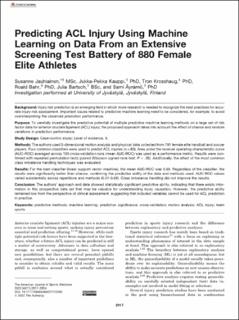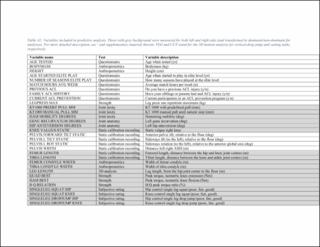| dc.contributor.author | Jauhiainen, Susanne | |
| dc.contributor.author | Kauppi, Jukka-Pekka | |
| dc.contributor.author | Krosshaug, Tron | |
| dc.contributor.author | Bahr, Roald | |
| dc.contributor.author | Bartsch, Julia | |
| dc.contributor.author | Äyrämö, Sami | |
| dc.date.accessioned | 2022-11-29T17:35:09Z | |
| dc.date.available | 2022-11-29T17:35:09Z | |
| dc.date.created | 2022-09-01T12:59:29Z | |
| dc.date.issued | 2022 | |
| dc.identifier.citation | The American Journal of Sports Medicine. 2022, 50(11), Side 2917-2924. | en_US |
| dc.identifier.issn | 0363-5465 | |
| dc.identifier.uri | https://hdl.handle.net/11250/3034848 | |
| dc.description | This article is distributed under the terms of the Creative Commons Attribution 4.0 License (https://creativecommons.org/licenses/by/4.0/) which permits any use, reproduction and distribution of the work without further permission provided the original work is attributed as specified on the SAGE and Open Access pages (https://us.sagepub.com/en-us/nam/open-access-at-sage). | en_US |
| dc.description.abstract | Background: Injury risk prediction is an emerging field in which more research is needed to recognize the best practices for accurate injury risk assessment. Important issues related to predictive machine learning need to be considered, for example, to avoid overinterpreting the observed prediction performance.
Purpose: To carefully investigate the predictive potential of multiple predictive machine learning methods on a large set of risk factor data for anterior cruciate ligament (ACL) injury; the proposed approach takes into account the effect of chance and random variations in prediction performance.
Study Design: Case-control study; Level of evidence, 3.
Methods: The authors used 3-dimensional motion analysis and physical data collected from 791 female elite handball and soccer players. Four common classifiers were used to predict ACL injuries (n = 60). Area under the receiver operating characteristic curve (AUC-ROC) averaged across 100 cross-validation runs (mean AUC-ROC) was used as a performance metric. Results were confirmed with repeated permutation tests (paired Wilcoxon signed-rank-test; P < .05). Additionally, the effect of the most common class imbalance handling techniques was evaluated.
Results: For the best classifier (linear support vector machine), the mean AUC-ROC was 0.63. Regardless of the classifier, the results were significantly better than chance, confirming the predictive ability of the data and methods used. AUC-ROC values varied substantially across repetitions and methods (0.51-0.69). Class imbalance handling did not improve the results.
Conclusion: The authors’ approach and data showed statistically significant predictive ability, indicating that there exists information in this prospective data set that may be valuable for understanding injury causation. However, the predictive ability remained low from the perspective of clinical assessment, suggesting that included variables cannot be used for ACL prediction in practice. | en_US |
| dc.language.iso | eng | en_US |
| dc.subject | ACL injury | en_US |
| dc.subject | cross-validation | en_US |
| dc.subject | machine learning | en_US |
| dc.subject | motion analysis | en_US |
| dc.subject | prediction significance | en_US |
| dc.subject | predictive methods | en_US |
| dc.subject | team sports | en_US |
| dc.title | Predicting ACL injury using machine learning on data from an extensive screening test battery of 880 female elite athletes | en_US |
| dc.type | Peer reviewed | en_US |
| dc.type | Journal article | en_US |
| dc.description.version | publishedVersion | en_US |
| dc.rights.holder | © 2022 The Author(s) | en_US |
| dc.source.pagenumber | 2917-2924 | en_US |
| dc.source.volume | 50 | en_US |
| dc.source.journal | The American Journal of Sports Medicine | en_US |
| dc.source.issue | 11 | en_US |
| dc.identifier.doi | 10.1177/03635465221112095 | |
| dc.identifier.cristin | 2047873 | |
| dc.description.localcode | Institutt for idrettsmedisinske fag / Department of Sports Medicine | en_US |
| cristin.ispublished | true | |
| cristin.fulltext | original | |
| cristin.qualitycode | 2 | |

